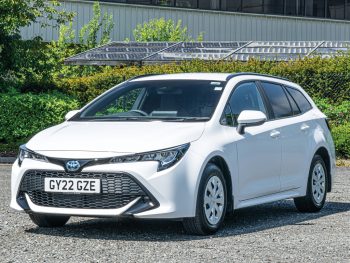Good news for van operators who need a small vehicle with low running costs, says John Kendall.

The 2021 CV Show provided the debut for Toyota’s Corolla Commercial, designed to gauge public reaction to Toyota’s proposed new van for the UK. A year later and Toyota has brought the new van to market, introducing a new car-derived van model based on the Corolla Touring Sports estate car.
There are now comparatively few car-derived vans on the market providing space for tools or light deliveries and none based on a family estate car. The Corolla Commercial has the added advantage of being built in the UK, at Toyota’s Burnaston plant near Derby. The company has carried out the conversion in-house at its Business Revenue Centre on the Burnaston site, removing the rear seats and replacing them with a load floor with rubber lining and full height steel bulkhead (solid steel lower half with mesh upper) as well as opaque film covering the rear windows to keep loads out of sight. This provides a useful 1.3m3 of load space and maximum payload of 425kg. The load space can be accessed through the rear tailgate and through the rear side doors.
As might be expected from a car-derived Toyota model, power comes from a petrol hybrid drivetrain, using Toyota’s fourth-generation parallel hybrid system, enabling either the engine or electric motor to drive the front wheels. The system combines a 1.8-litre Atkinson cycle petrol engine with an electric motor/generator and lithium-ion battery pack. Toyota quotes a combined output of 122hp, with maximum torque of 142Nm from the engine and 163Nm from the 53kW electric motor. The drive is transmitted through a CVT automatic transmission. There is no diesel alternative. Since Toyota quotes a combined WLTP fuel consumption of 55.60-61.4mpg and with fuel prices currently sky high, the good fuel consumption potential and lower price of petrol could be an advantage for the Corolla Commercial.
The small van comes with an impressive list of standard equipment. This includes Apple CarPlay and Android Auto and Toyota’s Safety Sense with pre-collision system. The pre-collision system will warn the driver of a collision risk with the vehicle in front and prepares the brakes to provide maximum stopping power.
Other standard features include adaptive cruise control, Lane Trace Assist with Sway Warning and Road Side Assist, Lane Departure Alert, heated and adjustable door mirrors, reversing camera, dual zone automatic air conditioning, heated height adjustable seats, automatic headlights and power adjustable lumbar support. It’s an impressive list with both safety items and driver comfort high on the agenda.
Behind the wheel it’s no surprise that the Corolla Commercial feels like a car to drive. The CVT system, with no stepped gear changes, makes the van almost as smooth as an electric vehicle, which it can be for short bursts. Like any conventional hybrid, you won’t get more than a mile or two of pure electric driving, but the important thing is that it reduces fuel consumption and emissions overall. It can be a brisk performer when you need it to be, helped by tidy handling and a comfortable ride.
The Corolla Commercial is the only hybrid van with a conventional parallel hybrid powertrain that does not require re-charging from a power socket.
IN BRIEF
WHAT IS IT? Small van
HOW MUCH? £22,149 (ex-VAT)
LOAD VOLUME? 1.3m3
PAYLOAD? 425kg
ECONOMY? 55.6-61.4mpg (WLTP)
DRIVE? 122hp @ 3,500rpm / 142Nm torque (engine) + 163Nm (electric motor)
VERDICT
With few competitors in the car-derived van sector now, the Corolla Commercial could easily find a ready market. The load area is modest but could prove just what’s needed for some small business operators.

